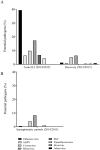Contribution of Influenza Viruses, Other Respiratory Viruses and Viral Co-Infections to Influenza-like Illness in Older Adults
- PMID: 35458527
- PMCID: PMC9024706
- DOI: 10.3390/v14040797
Contribution of Influenza Viruses, Other Respiratory Viruses and Viral Co-Infections to Influenza-like Illness in Older Adults
Abstract
Influenza-like illness (ILI) can be caused by a range of respiratory viruses. The present study investigates the contribution of influenza and other respiratory viruses, the occurrence of viral co-infections, and the persistence of the viruses after ILI onset in older adults. During the influenza season 2014-2015, 2366 generally healthy community-dwelling older adults (≥60 years) were enrolled in the study. Viruses were identified by multiplex ligation-dependent probe-amplification assay in naso- and oropharyngeal swabs taken during acute ILI phase, and 2 and 8 weeks later. The ILI incidence was 10.7%, which did not differ between vaccinated and unvaccinated older adults; influenza virus was the most frequently detected virus (39.4%). Other viruses with significant contribution were: rhinovirus (17.3%), seasonal coronavirus (9.8%), respiratory syncytial virus (6.7%), and human metapneumovirus (6.3%). Co-infections of influenza virus with other viruses were rare. The frequency of ILI cases in older adults in this 2014-2015 season with low vaccine effectiveness was comparable to that of the 2012-2013 season with moderate vaccine efficacy. The low rate of viral co-infections observed, especially for influenza virus, suggests that influenza virus infection reduces the risk of simultaneous infection with other viruses. Viral persistence or viral co-infections did not affect the clinical outcome of ILI.
Keywords: influenza virus infection; influenza-like illness; older adults; respiratory viruses; viral co-infections; viral interference.
Conflict of interest statement
The authors declare no conflict of interest.
Figures



References
-
- WHO Fact Sheet N°211: Influenza (Seasonal) [(accessed on 5 April 2022)]. Available online: http://www.who.int/mediacentre/factsheets/fs211/en/index.html.
-
- van Beek J., Veenhoven R.H., Bruin J.P., van Boxtel R.A.J., de Lange M.M.A., Meijer A., Sanders E.A.M., Rots N.Y., Luytjes W. Influenza-like Illness Incidence Is Not Reduced by Influenza Vaccination in a Cohort of Older Adults, Despite Effectively Reducing Laboratory-Confirmed Influenza Virus Infections. J. Infect. Dis. 2017;216:415–424. doi: 10.1093/infdis/jix268. - DOI - PMC - PubMed
-
- Falsey A.R., McElhaney J.E., Beran J., van Essen G.A., Duval X., Esen M., Galtier F., Gervais P., Hwang S.J., Kremsner P., et al. Respiratory syncytial virus and other respiratory viral infections in older adults with moderate to severe influenza-like illness. J. Infect. Dis. 2014;209:1873–1881. doi: 10.1093/infdis/jit839. - DOI - PMC - PubMed
Publication types
MeSH terms
LinkOut - more resources
Full Text Sources
Medical

